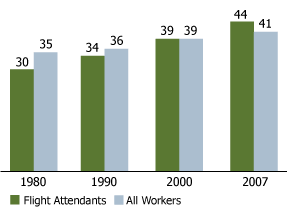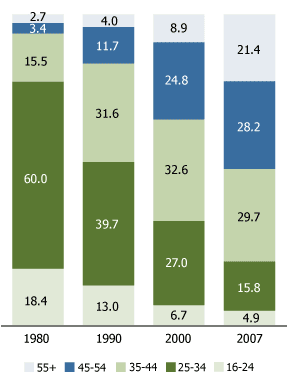
The Changing Demography of U.S. Flight Attendants
(June 2009) Over the last several decades, many industries have experienced significant structural changes that have affected their employees. The airline industry, for example, has faced major policy and economic forces that have changed the demography of its workers, especially its flight attendants.
Civil rights laws in the mid-1960s made it illegal for employers to discriminate on the basis of age, sex, or race. Thus, the airline industry had to abandon its preference for hiring young women as well as its no-marriage and no-pregnancy rules and weight restrictions. In addition, deregulation of the airline industry in the late 1970s led to a hiring freeze of flight attendants and an ensuing preferential treatment for hiring workers furloughed by other airlines.1 Finally, the Sept. 11 attacks resulted in significant layoffs of flight attendants. In this environment, many flight attendants with low levels of accrued seniority were often the first to be furloughed.
Flight attendants have become older compared with the overall U.S. workforce over the last several decades. The ongoing economic crisis suggests that the population of flight attendants will age even more in the coming years as many workers are likely to postpone their retirement.2
The Aging of Flight Attendants
The age structure of flight attendants has changed dramatically since 1980. While flight attendants were younger than the overall U.S. workforce in 1980, they are now older (see Figure 1).3 Indeed, between 1980 and 2007, the median age of all U.S. workers increased by six years (from 35 to 41), but the median age of flight attendants rose by 14 years (from 30 to 44).
Figure 1
Median Age of U.S. Flight Attendants and All U.S. Workers, 1980-2007

Source: American Community Survey data.
During this period, there has been a tremendous shift in the age distribution of flight attendants (see Figure 2). While the percentage of flight attendants younger than 35 dropped from 78 percent in 1980 to 21 percent in 2007, the percentage of these workers 45 years of age and older shot up from 6 percent in 1980 to 50 percent in 2007.
Figure 2
Age Distribution of U.S. Flight Attendants, 1980-2007 (%)

Source: American Community Survey data.
More Diversity, More Men, and Lower Real Wages
Other important changes have taken place among flight attendants since 1980. The racial and ethnic composition of flight attendants has become less white (82.6 percent were white in 1980 compared with 70 percent in 2007), and more black (8.5 percent in 1980; 14 percent in 2007) and Latino (4.9 percent in 1980; 9.1 percent in 2007). Still, Latinos are relatively underrepresented in this occupation.
Although flight attendants continue to be predominantly female, males have increased their presence between 1980 (19.3 males per 100 females) and 2007 (26.4 males per 100 females).
There has also been a dramatic shift in the earnings of flight attendants since 1980. After adjusting for inflation, the median hourly wages (in 2007 dollars) dropped by 26 percent between 1980 and 2007. In contrast, the median hourly wages of all U.S. workers rose by 13 percent during this period. Furthermore, while female flight attendants used to have higher wages than male workers (perhaps due to greater levels of seniority), males now have slightly higher wages.
Implications
We find that other segments of the airline industry have not aged as much as flight attendants. For example, the median age of airline pilots increased by six years and that of airline mechanics rose by four years between 1980 and 2007.
The existing economic crisis suggests that the population of flight attendants are likely to become increasingly older in the coming years, as many workers postpone retirement. Because health care needs escalate with age, flight attendants will likely have a significant impact on health care costs to the airline industry.
Rogelio Saenz is professor of sociology at Texas A&M University. Louwanda Evans is a doctoral student in the department of sociology at Texas A&M University. Evans is a former flight attendant. The authors appreciate earlier conversations with Joachim Singelmann on this topic as well as the helpful comments of Karen Manges Douglas on an earlier draft of this report.
References
- United Airlines, Flight Attendant History, accessed online at www.united.com/page/article/0,6722,3361,00.html, on May 28, 2009; Kathleen M. Barry, Femininity in Flight: A History of Flight Attendants (Durham, NC: Duke University Press, 2007); and Dorothy Sue Cobble,The Other Women’s Movement: Workplace Justice and Social Rights in Modern America (Princeton, NJ: Princeton University Press, 2005).
- Cheryl Corley, “Recession Keeps Older Flight Attendants in the Air,” accessed online at www.npr.org/templates/story/story.php?storyId=103502327&ft=1&f=1003&sc=emaf, on May 28, 2009; and Richard Morin, “Most Middle-Aged Adults Are Rethinking Retirement Plans: The Threshold Generation,” accessed online at http://pewresearch.org/pubs/1234/the-threshold-generation, on May 28, 2009.
- Data used in this report come from the 5 Percent Public Use Microdata Samples from the 1980, 1990, and 2000 decennial censuses and from the 1 Percent Public Use File of the American Community Survey (ACS). The data were downloaded from the I-PUMS website from the University of Minnesota at http://usa.ipums.org/usa/. Flight attendants include those whose occupation is “public transportation attendants” and whose industry is “airline transportation.”
